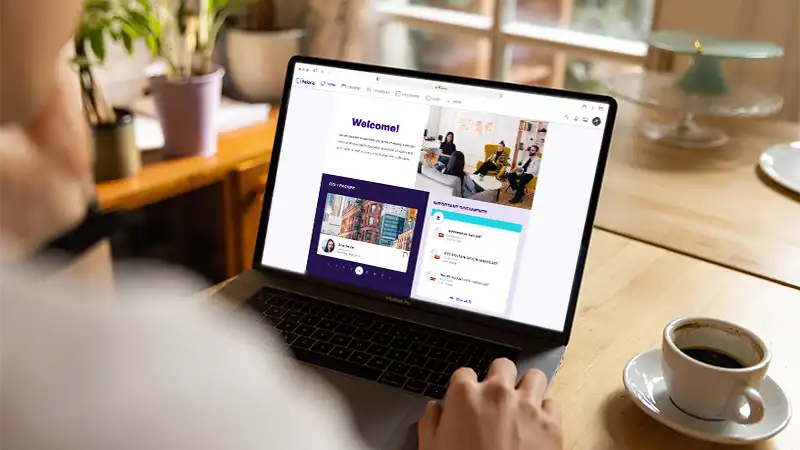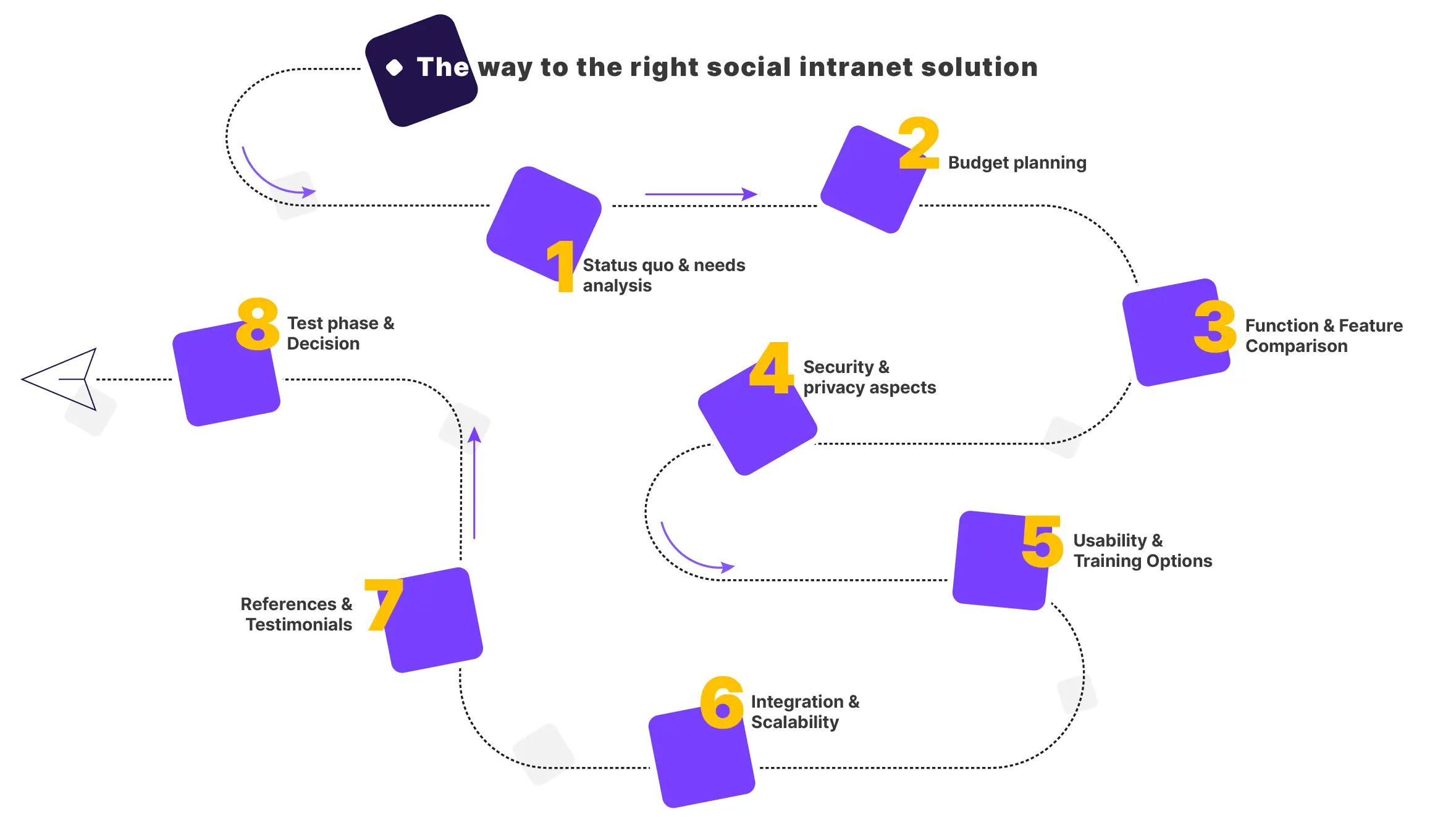Companies today are faced with the challenge of making internal communication more efficient and collaborative. One solution that is becoming increasingly popular is the social intranet. This platform not only facilitates the exchange of information, but also promotes collaboration between employees in a completely new way.
But what exactly is a social intranet, and what functions and benefits does it offer? In this article, you will learn everything you need to know to fully utilise the potential of a social intranet for your company.
Social intranet: definition and basics
What is a social intranet?
A social intranet is a digital platform that has been specially developed for internal communication and collaboration within a company. Unlike the classic intranet, which primarily serves as a pure source of information, a social intranet enables employees to actively interact with each other. Teams can work together on projects, exchange ideas and support each other with challenges. The social aspect and collaborative digital cooperation take centre stage and make the social intranet a valuable tool for modern companies.
How does a social intranet work?
A social intranet functions like a digital network within the company, combining various tools and functions on a central platform. The aim is to improve internal communication, make knowledge accessible and promote collaboration, regardless of location or device.
At its core, a social intranet is based on the following technical and functional principles:
- User-centric: Employees receive personalised content – e.g. based on their department, position or interests. An individual home page bundles relevant information, tasks and news.
- Interactive communication: Functions such as comments, likes, polls and chat allow employees to respond directly to content, give feedback and engage in dialogue, similar to social networks.
- Seamless integration: Modern social intranets are linked to existing tools (e.g. MS Teams, Google Workspace, HR systems), breaking down silos and making information centrally accessible.
- Role and rights distribution: Thanks to differentiated rights, content can be published in a targeted manner, for example, only for specific teams, locations, or target groups within the company.
- Mobile use: All functions are also available to non-desk workers and field staff via apps or mobile web views, which is a decisive advantage over traditional solutions.
A well-implemented social intranet thus becomes the digital home for employees, combining information, communication and collaboration in a single system.
Classic intranet vs. social intranet: What are the significant differences?
In many companies, the classic intranet is still in use as a static information platform without any real interaction. However, the demands placed on modern communication and collaboration have increased. This is where social intranets come in. They enable active exchange, promote participation and create a dynamic, networked working environment.
Advantages of a social intranet
A social intranet brings numerous strategic, operational and cultural benefits, both for companies as a whole and for individual employees and hard-to-reach target groups such as non-desk workers. Below is an overview of the most important added values.
For businesses: efficiency, transparency and culture
A social intranet has a positive impact on many key areas of a company:
- Improved internal communication: Information reaches all employees reliably without media breaks or loss of information.
- Higher productivity & faster processes: Through collaborative tools, integrated knowledge management and centralised information provision.
- Strengthening corporate culture: Feedback functions, recognition systems and interactive formats create a stronger sense of unity.
- Reduced email overload: information is shared in context, discussions take place transparently on the intranet.
- Data security & governance: Rights and role concepts ensure controlled content and GDPR-compliant communication.
For employees: Relevant information & active participation
The social intranet puts people at the centre with a clear focus on usability, relevance and participation:
- Personalised access to information: Everyone sees what is relevant to their own role, without information overload.
- Involvement & participation: Employees can comment on content, like it or create their own posts. Engagement promotes commitment.
- Easy access to knowledge and experts: Information and expertise can be found quickly using search functions, profiles and tags.
- Feedback & recognition: Features such as employee surveys, digital notice boards and kudos promote an open feedback culture.
- Flexibility & mobility: Access anytime, whether in the office, working from home or on the go.
For non-desk workers: finally connected and informed
A social intranet is a real game changer, especially for non-desk workers, e.g. in retail, production or logistics:
- Mobile use via app or web: All content is also available on private smartphones without complicated access procedures.
- Central communication & announcements: Shift schedules, updates, or safety information reach everyone, even those without an email address.
- Strengthening digital participation: Even employees without a fixed PC workstation can get involved, give feedback or view contributions.
- Employee retention & employer brand: Those who feel informed and involved identify more strongly with the company.
The most important functions of a social intranet
A social intranet offers a wide range of functions that facilitate both internal communication and collaboration within the company. In the following, some functions are explained in more detail:
A central platform that integrates various tools for collaboration and project work, including wikis, blogs, forums, chats and video conferencing. These tools facilitate exchange and collaboration between teams or departments, even if they are spread across different locations.
Employees can create a personalised home page tailored to their specific needs and relevant information. It is possible to set up individual profiles, interests and skills so that colleagues with similar backgrounds and skills can be found and contacted more easily.
The platform serves as a central storage location for documents such as manuals, guidelines, contracts and other important company information. A search function enables employees to quickly find, share and collaborate on relevant documents, which significantly increases efficiency.
An open feedback culture is promoted through functions such as surveys and evaluations. Sharing information about events, employee awards and other activities supports employee engagement and motivation.
The sharing of experience and knowledge by employees is actively supported, which promotes knowledge management within the company. Internal knowledge transfer is accelerated through the creation of expert lists and the ability to ask experts specific questions.
Goals of a social intranet
Die 5 wichtigsten Ziele
A social intranet promotes the fast and direct exchange of information, which reduces misunderstandings and makes communication within the company more efficient.
Through shared digital platforms and tools, a social intranet enables improved collaboration between teams and departments, regardless of location or department.
With a social intranet, information and knowledge can be stored centrally and made easily accessible, which increases transparency within the company and facilitates the transfer of knowledge.
A social intranet offers a wide range of opportunities for participation, which increases employee commitment and motivation.
By promoting open communication and active collaboration, a social intranet helps to develop and strengthen a positive and transparent corporate culture.
Practical examples from various industries
A social intranet can be used across all industries, but its specific benefits vary depending on the sector. Here are a few selected practical examples:
- Industry & Production: In a manufacturing company, the social intranet serves as a central platform for shift schedules, safety instructions and feedback from the shop floor. Employees can report problems, submit suggestions or participate in internal discussions.
- Healthcare: Clinics and care facilities use social intranets to connect teams across locations, make duty rosters transparent and provide training content digitally. Mobile availability is particularly relevant here for shift workers.
- Trade & Retail: Branch employees stay informed about company news, product updates, or internal promotions. Centralised communication replaces outdated notices and memos. Interactive formats such as employee surveys promote dialogue with headquarters.
- Administration & public institutions: Authorities and municipal institutions benefit from structured communication and improved knowledge management. Projects and internal services are organised more efficiently via the intranet.
Use cases for non-desk employees
Non-desk workers, i.e. employees without a fixed office workplace, make up the largest proportion of the workforce in many companies. Nevertheless, they are often not integrated into traditional communication structures, or only to an insufficient extent. A social intranet provides a remedy here:
- Interactive shift communication: Shift changes, duty rosters or last-minute announcements are communicated directly via push notifications or news feeds, even without an analogue notice board.
- Feedback from the workplace: Employees can provide direct feedback on processes, safety or suggestions for improvement using simple forms, quick polls or comment functions.
- Digital induction & training: Micro-learning formats, video tutorials and FAQ sections are available on the go at any time, ideal for new team members or seasonal staff.
- Cross-location exchange: Group functions enable non-desk teams to network with colleagues from other branches or plants and exchange best practices.
- Commitment & belonging: Birthdays, team successes or internal challenges are made visible, which promotes culture beyond the head office.
Implementing a social intranet
The introduction of a social intranet is more than just a technical change – it is a process of change that must be strategically planned and accompanied by communication. From needs analysis and selecting the right platform to employee activation: only those who take a structured approach will realise the full potential. In our 6-step guide, we show you how to successfully implement your social intranet.
Requirements & selection criteria
Not every platform meets the requirements of modern corporate communication. For a social intranet to work in the long term, it must be technically suitable, comply with data protection regulations and meet the needs of users, especially in terms of usability and mobile use. In our guide, you will learn which technical, legal and functional criteria you should consider when making your selection.
Social intranet providers & solutions
The market for social intranets is diverse, ranging from specialised niche solutions to comprehensive all-in-one platforms. Companies face the challenge of finding a solution that fits both their technical and strategic goals.What to look for when choosing?
Die Auswahl eines passenden Social Intranets sollte nicht rein funktionsbasiert erfolgen. Vielmehr gilt es, folgende Kriterien in die Bewertung einzubeziehen:- Scalability & Modularity: Can the solution be adapted to future requirements?
- User-friendliness: How intuitive is the interface, even for non-desk workers?
- Integration of existing systems: Can the intranet be easily connected to tools such as MS Teams, HR software or file management systems?
- Mobile use & app capability: Particularly relevant for companies with field staff or decentralised teams.
- Security standards & data protection: GDPR compliance, hosting location and encryption are mandatory.
Polario as a social intranet solution
Polario offers a modern, modular solution for companies that want to improve their internal communication and collaboration in the long term. With a clear focus on mobile-first, intuitive user guidance and high customisability, Polario is suitable for both medium-sized and large organisations.cost overview
The cost of a social intranet depends heavily on the provider chosen, the features required and the size of the company. Typical price factors are:
- Licence model: per user, per month or flat rate
- Functionality: Basic version vs. advanced collaboration tools
- Support & service level: e.g. individual onboarding support or SLA
- Customisation & Interfaces: Individual extensions or system connections
Many providers offer tiered pricing models or modular packages, so it is important to make a transparent comparison in advance.
Internal communication via the social intranet
A key advantage of the social intranet is its function as a versatile communication platform. Employees can use the social intranet to exchange information efficiently and collaborate seamlessly.
Thanks to functions such as chats, channels, comments and groups, employees can communicate with each other and share ideas quickly and easily. These tools not only facilitate day-to-day communication, but also enable collaboration across different locations or in the home office. This strengthens the sense of community within the company, regardless of where employees are located.
The importance of real-time communication
Fast and effective communication is of great importance for companies, especially with remote work and decentralised teams. A social intranet enables real-time communication in which information can be passed on directly to all participants.
As a result, decisions can be made more quickly and processes accelerated, which promotes collaboration and productivity. The ability to send and receive messages in real time increases responsiveness and supports flexible workflows within the company.
Functions for successful internal communication
For successful internal communication on the social intranet, companies should rely on functions that support collaboration and the exchange of information. The most important functions include:
Chats for quick and uncomplicated consultations
Enable immediate communication between employees to make quick decisions.
Channels for discussions and exchanging ideas
Promote topic-specific exchange and improve collaboration in groups.
Comment functions for feedback and discussions on content
Facilitate direct feedback on documents and projects, which increases the quality of work.
Group functions for collaboration on projects
Provide specialised spaces where teams can work together on tasks and track progress.
8 steps to the optimal social intranet: How to choose the right one
A social intranet should not only look good, but also truly suit the company functionally, technically and culturally. But how do you approach the selection process in a structured way? Our 8-step plan helps you keep track of things and avoid making the wrong decisions. From needs analysis to the test phase. Here you can find out how to find the right system for your company.
Strategies for promoting the use of your social intranet
A good social intranet only reveals its value when it is actively used. But how can you motivate employees to use it on a long-term basis? In addition to a well-planned introduction, targeted measures for training, activation and a feedback culture are required. In this article, we present tried-and-tested strategies that you can use to increase the use of your social intranet in the long term.
Social Intranet ist kein Tool sondern ein Kulturwandel
The social intranet offers numerous advantages for companies and employees. It promotes internal communication and collaboration, improves efficiency and facilitates access to important information. However, it should also be kept in mind that there may be potential disadvantages such as privacy issues.
Companies should therefore always think carefully about the goals they are pursuing with the introduction of a social intranet and which functions are really necessary. Choosing the right system is critical to the success of the project and should be carefully planned.
You might also be interested in

Learn the 10 most important best practices for measurably improving your internal corporate communications.

How can you communicate change successfully? Use this checklist to plan all your communication measures, including practical examples and tips.
Frequently asked questions (FAQ)
What is the difference between a traditional intranet and a social intranet?
A classic intranet primarily serves to distribute information from the top down. A social intranet also enables interactive communication, collaboration and participation, similar to social networks.
Which companies benefit most from a social intranet?
Vor allem mittelständische und größere Unternehmen mit verteilten Standorten oder Non-Desk Workern profitieren. Aber auch Organisationen mit dem Wunsch nach mehr Transparenz, Partizipation und Engagement können stark profitieren.
What features should a good social intranet offer?
Important features include news feeds, personalisation, chat, groups, document management, employee profiles, feedback tools and mobile usage options.
How long does it take to implement a social intranet?
That depends on the scope. Typically, implementation, including planning, training and roll-out, takes between 2 and 6 months.
Is a social intranet also useful for smaller companies?
Yes, provided that communication, collaboration and knowledge sharing are key challenges. There are scalable solutions that are also suitable for smaller teams.
How can acceptance among employees be increased?
Through targeted training, early involvement, clear communication of benefits and incentive systems. Our article on 3 strategies can help here.
What role does data protection play in social intranets?
A centralised one. The solution should be GDPR-compliant, offer role-based access rights and be hosted on secure servers, ideally in the EU.
What does a social intranet cost?
The costs vary depending on the provider, range of functions and number of users. There are licence models starting at just a few pounds per user/month, but also individual enterprise offers.
How do I measure the success of a social intranet?
Typical KPIs include usage rate, engagement, shared content, feedback rate, and qualitative employee satisfaction surveys.
Can a social intranet replace existing tools such as MS Teams?
A social intranet complements and integrates existing tools in a meaningful way. A good intranet creates the content and structural framework that tools such as Teams or Slack do not offer.



